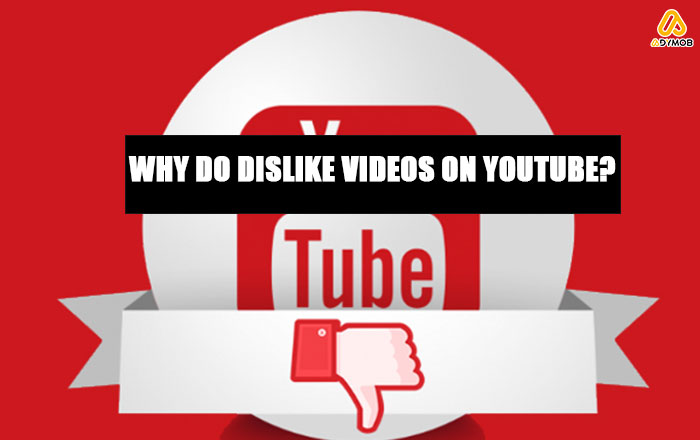Have you ever paid attention to the YouTube dislike button under the posts? Do you know what they mean?
Some users keep asking us: should I dislike videos on YouTube? In this article, we have gathered the reasons that most YouTubers click to dislike videos. We also examine the impact of YouTube’s dislike for the creators and viewers.
Don’t Panic! In this guidance, you will learn to turn YouTube dislikes into growth. Are you feeling down because your latest video bombed? Dislikes got you bummed? Hold on! That thumbs-down might not be the disaster you think.
Yes, a lack of love stinks, but before you spiral, remember that dislikes aren’t the end of your channel.
To learn more about disliked videos on YouTube, stay with us until the end.
What Happens When You Dislike a Video on YouTube?
You might have disliked a video on YouTube and wondered: ok! What happens next? Did I just hurt the creators’ feelings, or is it an effective way to show the algorithm that I am not interested in this content?
Do you want to know what happens after disliking videos on YouTube? Let’s check it out.
![]() When you dislike a video on YouTube, a few things happen, both visible and behind the scenes:
When you dislike a video on YouTube, a few things happen, both visible and behind the scenes:
· Immediate Impact
Previously visible publicly, the dislike count has been no longer shown since November 2021. Only the creators can see the exact number of dislikes on their videos.
The immediate impact when you dislike a video on YouTube is that you will only see the recommended footage again when you search for the content.
· Behind The Scenes
After disliking a video on YouTube, two things happen behind the scenes, and here you can see them:
- Feedback for the creator: The viewers won’t see the likes count, but dislikes still act as feedback for the creator. They can see the total number of dislikes and analyze them with other insights like comments and watch time to understand viewer sentiment. Also, they will understand the viewers’ tastes and know which content will likely get more views.
- Algorithm input (controversial argument): While YouTube claims that dislikes have no substantial impact on recommendations, others feel they do contribute to an internal system that determines video appearance to some level. Yet this has to be formally confirmed, and the specific circumstances are unclear.

![]() Key points to remember while disliking videos on YouTube:
Key points to remember while disliking videos on YouTube:
- Disliking a video mainly acts as feedback for the creator and will not directly harm their channel or viewership.
- YouTube dislikes are hidden from public view to prevent “dislike attacks” and harassment towards creators.
- The impact of dislikes on video recommendations is debated and
needs to be clarified.
Disking a video provides a way to express your opinion, but it is just one piece of the puzzle in YouTube’s recommendation system.
Now, let’s find out why viewers dislike Instagram.
What Are the Reasons that Viewers Dislike Videos on YouTube?
Youtubers can have various motivations when they hit that thumbs-down on YouTube! It is not just because they hated the video.
![]() Let’s explore the different motivations to dislike videos on YouTube:
Let’s explore the different motivations to dislike videos on YouTube:
1. Genuine Dislike
One of the main reasons is that some viewers prefer to avoid the video. It might not suit their preferences, or the topic might not interest them. Disliking is their way of expressing that point of view.
2. Feedback Loop
Some of the viewers use dislikes on YouTube as feedback for creators. This feedback can be in various fields. Do not take it personally. The audio quality could have been better, the editing dragged, or the information felt inaccurate. A YouTube dislike signals these areas for improvement.
3. Trolling the Creator
Unfortunately, some YouTubers use dislike to be negative. And there is no other explanation.
They may dislike videos because they loathe the maker personally rather than because of the content. This focused negativity can strongly discourage creators.
A note to creators: It is better to know that not all the dislikes are malicious. You can use some of them as practical feedback.
As a creator, staying focused on genuine criticism and using it to improve while ignoring the purely negative noise is essential.

How To Deal with Dislikes on YouTube?
You can turn the dislikes into growth tools, so do not fear them. You might not be aware, but the dislikes offer valuable feedback for creators. Here’s how to deal with them effectively:
Ø Analyze the Data
Creators can access the dislike metrics in Creator Studio. They can track trends and patterns across videos. Are the video dislikes consistent, spiking, or concentrated in specific types of content?
Ø Identify Patterns
Look for connections between dislikes and other factors like topic, audio quality, editing style, or format. Did a new microphone lead to dislikes? So you can change it right away! Did the Q&A cause trouble? Well, change the questions.
Ø Use Feedback to Improve
YouTube Dislikes aren’t personal attacks (in most cases!); they are valuable insights. Use them to refine your content! You can upgrade the equipment, adjust your approach, or experiment with different formats based on dislike patterns.
Ø Don’t Obsess
The dislikes are just one data point. Focus on the things that matter the most: engagement, watch time, and positive feedback.
Bringing This to A Close
You can embrace the YouTube video dislikes as users’ reactions and transform them into more powerful tools for improvement and channel growth.
So, don’t let the thumbs down dishearten you – see them as opportunities to learn and elevate your content! As you saw in this article, the reasons behind a YouTube dislike are just as diverse as the platform itself.
Everyone knows that the dislikes are hidden from the public, but understanding the “why” behind dislikes is crucial for any creator.
Now it is time for you to share your opinion in the comments and tell us why you think users dislike videos on YouTube.
We are waiting for your comments.


